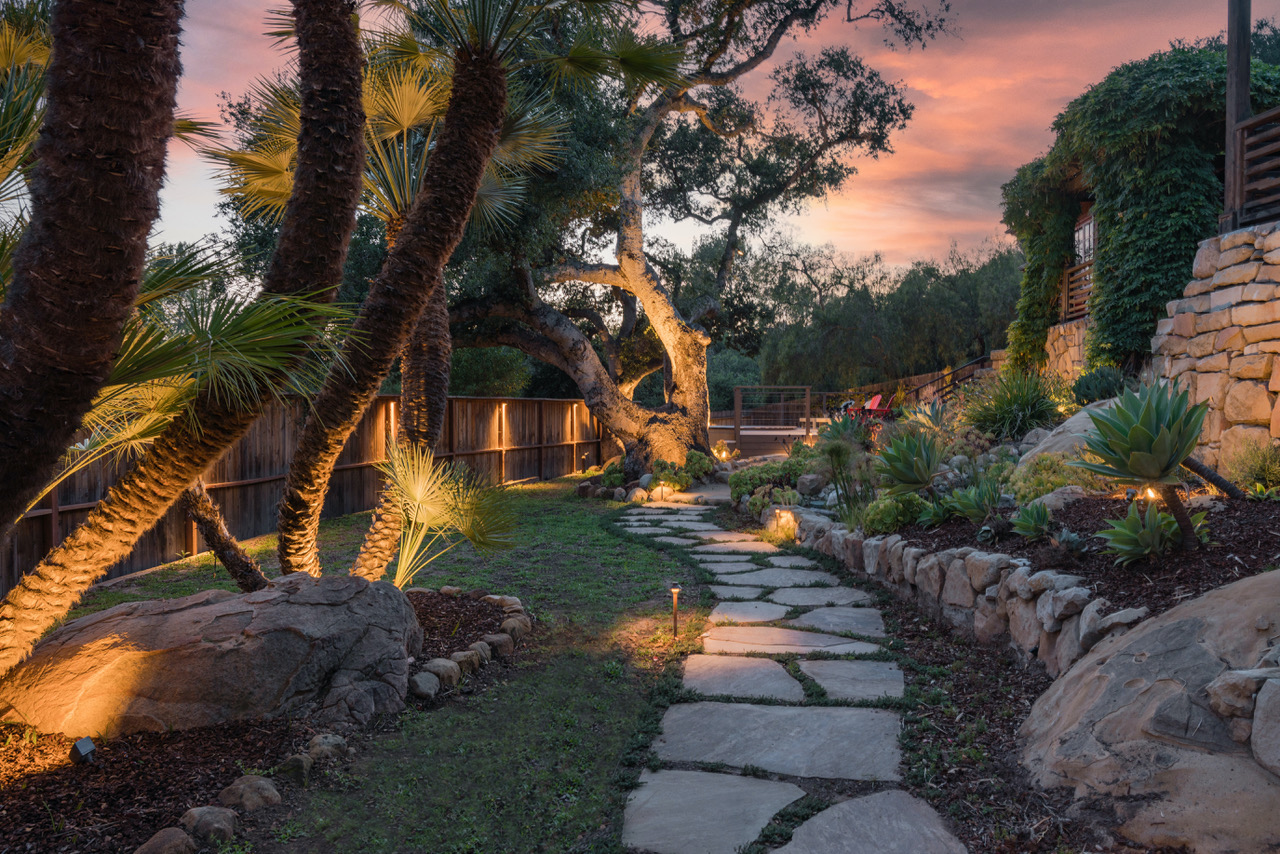Property Landscaping: Options to Reduce Water Use

Montecito is home to an array of birds, vibrant native plants, and rolling green lawns, all dependent on one resource: water. Recently, the question of water reuse has circulated throughout the community. Should Montecito create systems for non-potable water reuse? Potable reuse? Implementing these systems is prudent but will be costly and take time.
The recently updated Montecito Water District drought ordinance (Ordinance 97), adopted following an extremely dry start to the year and the State’s correlating new regulations, highlights the urgent need for the community to think proactively about water consumption and reduction moving forward. There is a simple way to begin decreasing water dependence and build a more resilient community starting right now.
“Eighty percent of your water bill, oftentimes somewhere between 60 and 80%, normally goes to your landscape,” Beau Schmidt, Co-Founder and President of EcoLawn, said. His company provides services to transition homeowners away from traditional lawns, installing low-water grass alternatives, artificial grass, native plant gardens, hardscapes, pools, and outdoor lighting. Schmidt, a general contractor by trade, started the company at the height of the drought in 2014. Now, he works in the Santa Barbara area, saving customers both water and money, creating thoughtfully curated, livable spaces. “When we go in and retrofit a residence, we can cut their water bill down by oftentimes 50%.”
In Montecito, single-family residences used an average of 255 gallons of water per capita per day from 2016-2020. Only 20% of water, the percentage used indoors, is eligible for reuse. The remaining 80%, which is dispensed to sustain the increasingly thirsty flora of property landscaping, is absorbed by these plants, and cannot be reused. In Montecito, this largely means grass lawns.
“We as people who want to landscape need to adapt,” said Ken Owen, Co-Founder and Executive Director of Channel Islands Restoration (CIR), a nonprofit that works to restore the Channel Islands and adjacent mainland to native plant ecosystems. Owen was on Santa Cruz Island 20 years ago helping remove invasive plants, but today he mostly works on the mainland along the Central Coast. CIR also works with volunteers and uses grants to take kids from low-income school districts to the beach or to the Channel Islands, aiming to get the public involved and educated on habitat restoration. Owen, who is a licensed landscape contractor, is passionate about creating healthier ecosystems in his local Santa Barbara area. “We as people who want to landscape need to adapt to that change, we can’t just go on planting ornamental plants that require large amounts of water and are not really adapted to a Mediterranean climate.”
EcoLawn and similar landscaping companies provide a service that can both adapt yards to declining precipitation and decrease costs in the process. Schmidt offers a grass alternative called Kurapia, a deep-rooted grass that requires far less water than traditional grass and only needs to be mowed once or twice a month. “We save people a lot of money,” he said. “It’s definitely an upfront investment, but it does save money in the long run.”
Kurapia and grass alternative Dymondia each have an average ROI (Return on Investment) of seven years. Based on Montecito Water District data and Santa Barbara County water costs, where costs increase rapidly over certain thresholds of water usage, switching from a traditional grass lawn to one of Kurapia or Dymondia would cut the average Montecito water bill down to nearly 1/7 of the cost.
“Normally we’ll do native landscaping in the front of a property. We’ll get rid of the lawn in the front unless they use that lawn,” Schmidt said. “And then we’ll go into the backyard, and maybe they have this huge lawn back there, and we’ll shrink it down to like 50%, so they have a usable space, if they have pets or kids.”
Switching from a traditional grass lawn to a combination of alternative lawn and native plant landscaping can save buckets of money, a ton of water, and can make your yard more fire resistant. Doing so can also provide additional benefits to the larger ecosystem.
“[In] Santa Barbara, Carpinteria, Montecito, people love to attract hummingbirds. They have bird feeders, but one of the best things you can do for local birds is plant local plants,” Owen said. “We’re really good at putting seed or nectar out, but people don’t realize that hummingbirds eat insects and other invertebrates on plants [too]. When you switch to a native garden, you’re also creating a habitat.”
Both the Santa Barbara Botanic Garden and Lotusland house some of the region’s most unique and beautiful plants. To create native gardens in Montecito, Ken recommends California natives Catalina Cherry and Torrey Pine as well as Santa Barbara natives Lemonade Berry, Monkey Flower, California Lilac, and an array of succulents like the highly varied species of Dudleya liveforevers. All these plants support local fauna and require far less water than non-native alternatives. “The only warning I will say is if you live near the wild-urban interface, I urge you to plant only local natives, because the natives from other places like Catalina Cherry, can spread into the native environment,”Owen said.
Whether you’re tired of taking care of your lawn or you just want to cut a chunk out of your water bill, transitioning towards a native, drought-tolerant garden provides an environmentally beneficial solution. Montecito has the ability, here, to become a beacon of water sustainability.
Asher Radziner is a Junior at Brown University, concentrating in Conservation Science and Policy. He works to find environmental solutions and unite people across boundaries.





